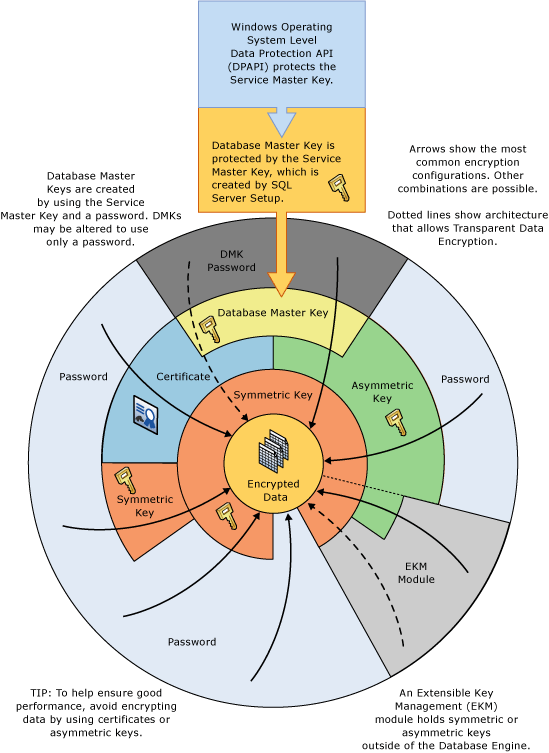Transparent Data Encrption:-
Symmetric / Asymmetric
==================================================================
To use TDE, follow these steps: -
==================================================================
USE master;
GO
CREATE MASTER KEY ENCRYPTION BY PASSWORD = '<UseStrongPasswordHere>';
go
CREATE CERTIFICATE MyServerCert WITH SUBJECT = 'My DEK Certificate';
go
USE AdventureWorks2012;
GO
CREATE DATABASE ENCRYPTION KEY
WITH ALGORITHM = AES_128
ENCRYPTION BY SERVER CERTIFICATE MyServerCert;
GO
ALTER DATABASE AdventureWorks2012
SET ENCRYPTION ON;
GO
========================================================================
Symmetric / Asymmetric
==================================================================
To use TDE, follow these steps: -
- Create a master key
- Create or obtain a certificate protected by the master key
- Create a database encryption key and protect it by the certificate
- Set the database to use encryption
==================================================================
USE master;
GO
CREATE MASTER KEY ENCRYPTION BY PASSWORD = '<UseStrongPasswordHere>';
go
CREATE CERTIFICATE MyServerCert WITH SUBJECT = 'My DEK Certificate';
go
USE AdventureWorks2012;
GO
CREATE DATABASE ENCRYPTION KEY
WITH ALGORITHM = AES_128
ENCRYPTION BY SERVER CERTIFICATE MyServerCert;
GO
ALTER DATABASE AdventureWorks2012
SET ENCRYPTION ON;
GO
========================================================================

==================================================================
TDE in Azure : -
Transparent data encryption encrypts the storage of an entire database by using a symmetric key called the database encryption key. This database encryption key is protected by the transparent data encryption protector. The protector is either a service-managed certificate (service-managed transparent data encryption) or an asymmetric key stored in Azure Key Vault (Bring Your Own Key).
SQL Server running on an Azure virtual machine also can use an asymmetric key from Key Vault. The configuration steps are different from using an asymmetric key in SQL Database and SQL Managed Instance.
In Azure, the default setting for transparent data encryption is that the database encryption key is protected by a built-in server certificate. The built-in server certificate is unique for each server.
- Customer-managed transparent data encryption - Bring Your Own Key
TDE in Azure : -
Transparent data encryption encrypts the storage of an entire database by using a symmetric key called the database encryption key. This database encryption key is protected by the transparent data encryption protector. The protector is either a service-managed certificate (service-managed transparent data encryption) or an asymmetric key stored in Azure Key Vault (Bring Your Own Key).
SQL Server running on an Azure virtual machine also can use an asymmetric key from Key Vault. The configuration steps are different from using an asymmetric key in SQL Database and SQL Managed Instance.
In Azure, the default setting for transparent data encryption is that the database encryption key is protected by a built-in server certificate. The built-in server certificate is unique for each server.
- Customer-managed transparent data encryption - Bring Your Own Key
No comments:
Post a Comment